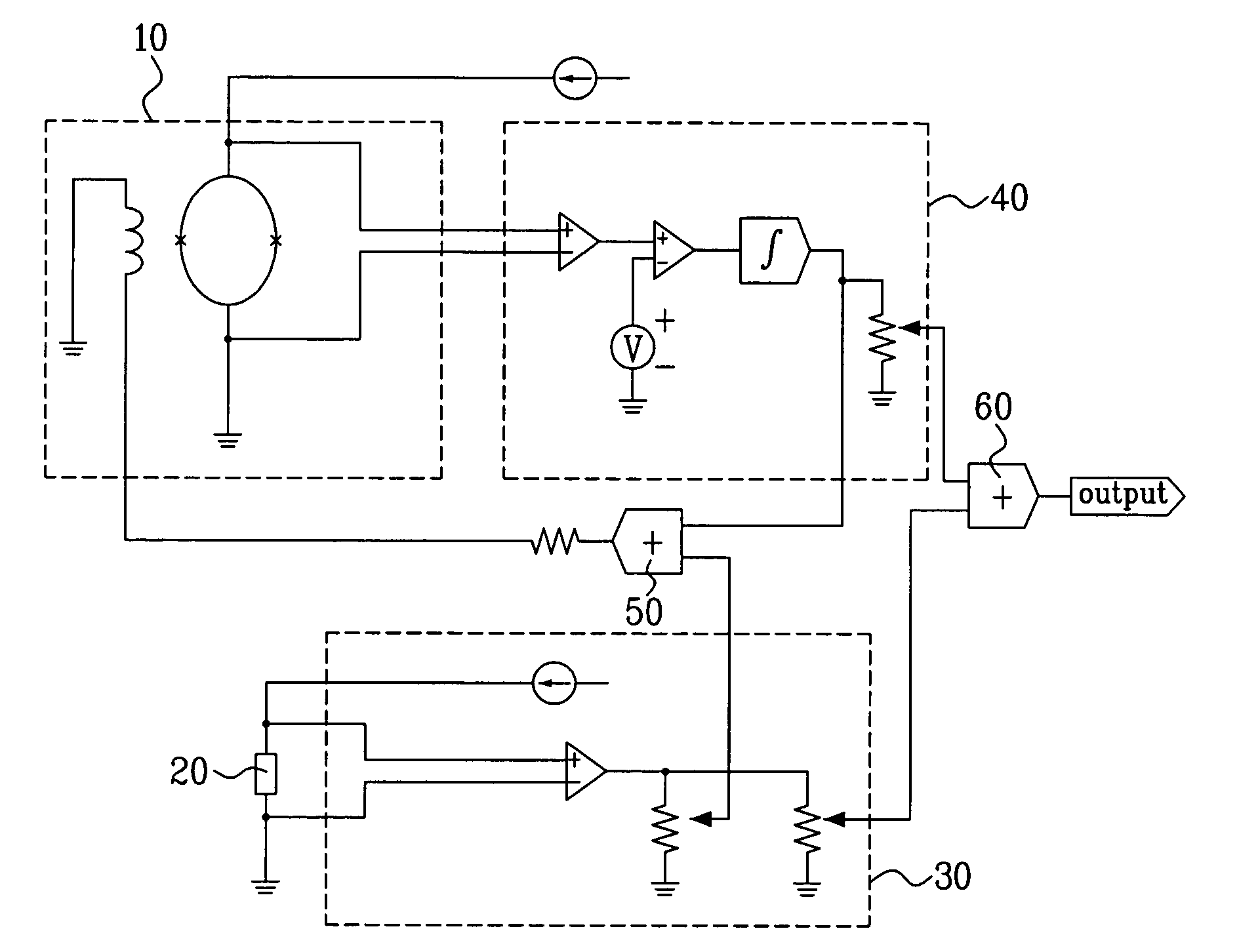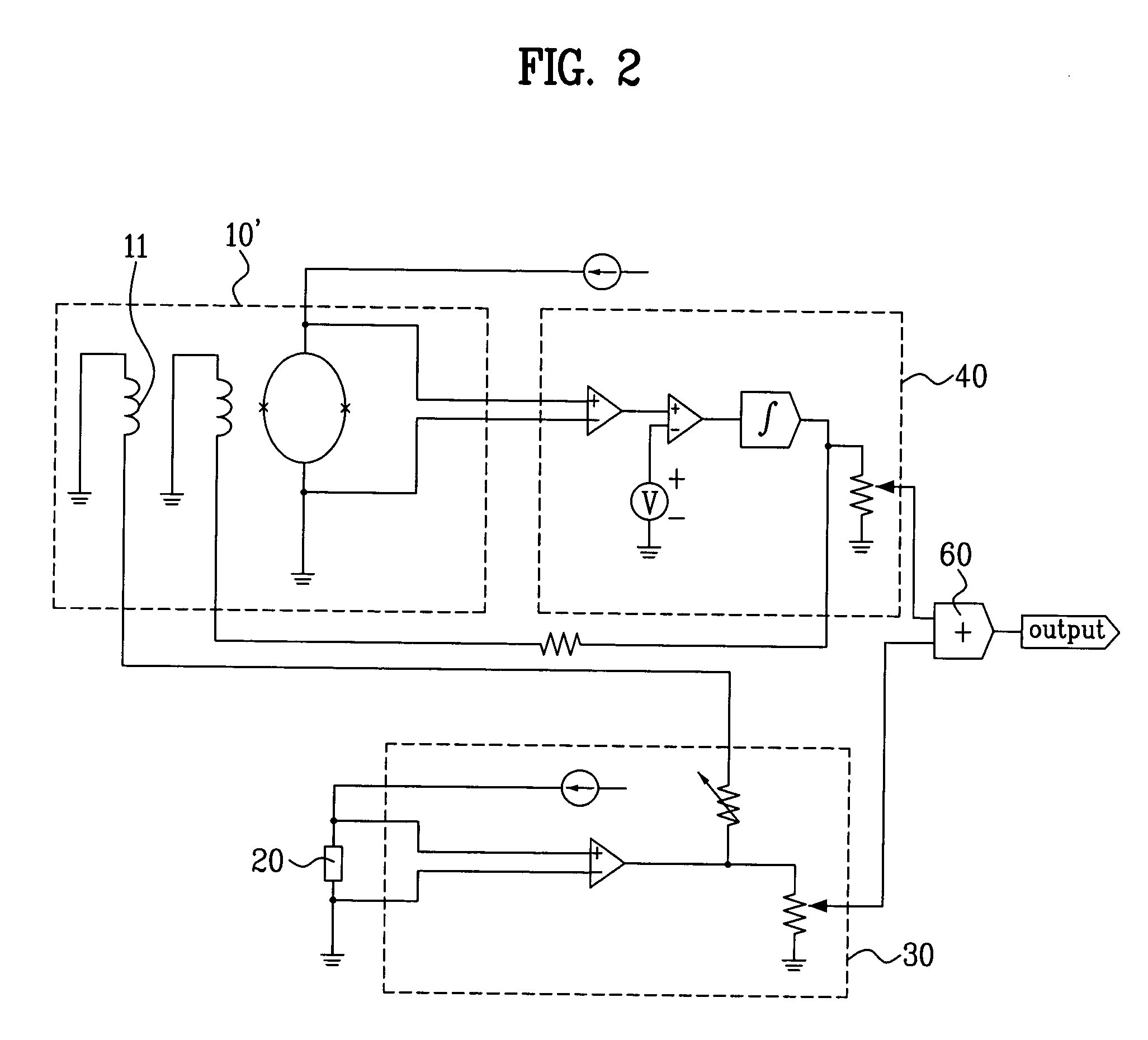Squid sensor using auxiliary sensor
a technology of auxiliary sensor and squid, which is applied in the direction of magnetic field measurement using superconductive devices, instruments, and material magnetic variables, etc., can solve the problems of high shielding cost, large magnetic field generated by refrigerators, and difficulty in exact signal analysis of squid signals, so as to improve the signal-to-noise ratio of squid driving circuit, reduce the generation of additional noise, and reduce the effect of squid performance degradation
- Summary
- Abstract
- Description
- Claims
- Application Information
AI Technical Summary
Benefits of technology
Problems solved by technology
Method used
Image
Examples
first embodiment
[0036]The present invention uses an arbitrary magnetic sensor having a poor performance whereas having a large input range comparing with a SQUID to form an offset magnetic field having a noise level higher than a self-noise level of the SQUID, such that the offset magnetic field can cause a noise-eliminated output to be provided to thereby easily embody a SQUID appliance in a general magnetic field. Together with this, in a first embodiment using the arbitrary magnetic sensor, a method is proposed for preventing a performance degradation of the SQUID from the magnetic field generated at the refrigerator as a key element of the SQUID.
[0037]FIG. 1 is a circuit diagram illustrating a SQUID sensor using an auxiliary sensor according to a first embodiment of the present invention.
[0038]Referring to FIG. 1, the SQUID sensor using the auxiliary sensor includes a SQUID sensing unit 10 comprised of the SQUID and a feedback coil for creating a magnetic field at a periphery of the SQUID; an a...
fourth embodiment
[0062]FIG. 4 is a schematic diagram illustrating the SQUID sensor using the auxiliary sensor with the refrigerator according to the present invention.
[0063]As shown in FIG. 4, the SQUID sensor includes a SQUID sensing unit 10 comprised of the SQUID and a feeback coil for creating the magnetic field in a periphery of the SQUID; a low-priced auxiliary sensor 20 having a magnetic sensitivity less than the SQUID sensing unit 10, but having a large operation range; a sensor reading unit 300 for operating the SQUID sensing unit 10 and the auxiliary sensor 20 to read out an output signal of the SQUID; and a refrigerator 100 for continuously or frequently maintaining the low temperature.
[0064]The refrigerator 100 includes a motor unit 130 comprised of a permanent magnet and a fixed electro-magnet; a coolant 120 for moving a low temperature atmosphere caused by the motor unit 130; and a cold end 110 for transmitting the coolant 120 to the SQUID sensing unit 10 to maintain the low temperature...
fifth embodiment
[0068]FIG. 5 is a detailed diagram illustrating the SQUID sensor using the auxiliary sensor with the refrigerator according to the present invention.
[0069]As shown in FIG. 5, the SQUID sensor includes a SQUID sensing unit 10 comprised of the SQUID and a feedback coil for creating a magnetic field at a periphery of the SQUID; a low-priced auxiliary sensor 20 having a magnetic sensitivity less than the SQUID sensing unit 10, but having the large operation range; a sensor reading unit 300 for operating the SQUID sensing unit 10 and the auxiliary sensor 20 to read out a signal of the SQUID and at the same time, supplying the SQUID sensing unit 10 with the offset magnetic field through the feedback coil; and a refrigerator (not shown) for continuously or frequently maintaining the SQUID sensing unit 10 to be in the low temperature outside.
[0070]At this time, the sensor reading unit 300 uses a flux-locked-loop (FLL) as a basic circuit for driving the SQUID, and reads out the magnetic fiel...
PUM
 Login to View More
Login to View More Abstract
Description
Claims
Application Information
 Login to View More
Login to View More - R&D
- Intellectual Property
- Life Sciences
- Materials
- Tech Scout
- Unparalleled Data Quality
- Higher Quality Content
- 60% Fewer Hallucinations
Browse by: Latest US Patents, China's latest patents, Technical Efficacy Thesaurus, Application Domain, Technology Topic, Popular Technical Reports.
© 2025 PatSnap. All rights reserved.Legal|Privacy policy|Modern Slavery Act Transparency Statement|Sitemap|About US| Contact US: help@patsnap.com



